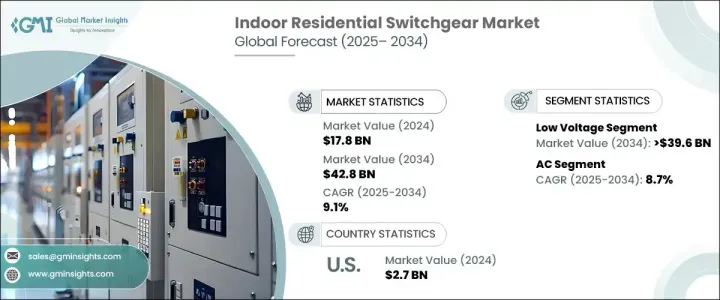
|
시장보고서
상품코드
1716564
실내 주거용 스위치기어 시장 : 기회, 성장 촉진요인, 산업 동향 분석 및 예측(2025-2034년)Indoor Residential Switchgear Market Opportunity, Growth Drivers, Industry Trend Analysis, and Forecast 2025 - 2034 |
||||||
세계의 실내 주거용 스위치기어 시장은 2024년에 178억 달러로 평가되었으며, 2025년부터 2034년에 걸쳐 CAGR 9.1%로 견조하게 성장할 것으로 예측되고 있습니다.
이 시장은 급속한 도시화와 스마트 홈 기술의 광범위한 통합으로 인해 전 세계 전력 소비가 계속 증가함에 따라 상당한 성장을 보이고 있습니다. 주거 공간이 더욱 첨단화되고 기술 중심이 되면서 안정적이고 효율적이며 지능적인 배전 솔루션의 필요성이 그 어느 때보다 중요해지고 있습니다. 현대의 주택 소유주들은 전기를 안전하게 배전할 뿐만 아니라 전반적인 에너지 관리를 개선하고 주택 안전에 기여하는 시스템을 점점 더 많이 찾고 있습니다.

스마트 에너지 관리 시스템에 대한 수요 증가와 함께 에너지 효율성에 대한 인식이 높아지면서 고급 실내 주거용 스위치기어의 채택이 촉진되고 있습니다. 또한 스마트 시티 개발과 재생 에너지원의 통합을 지원하는 정부 이니셔티브가 증가함에 따라 더 스마트하고 안전하며 에너지 효율적인 주거 인프라에 대한 수요가 증폭되고 있습니다. 에너지 낭비를 줄이고 전기적 위험을 방지하는 데 더 중점을 두고 있는 스위치기어 제조업체는 더 작고 내구성이 뛰어나며 기술이 적용된 제품을 시장에 출시하여 업계의 성장 기회를 확대하기 위해 혁신하고 있습니다.
| 시장 범위 | |
|---|---|
| 시작 연도 | 2024년 |
| 예측 연도 | 2025-2034년 |
| 시작 금액 | 178억 달러 |
| 예측 금액 | 428억 달러 |
| CAGR | 9.1% |
스마트 스위치기어는 주택 소유자가 전기 부하를 원격으로 모니터링하고 제어할 수 있게 하여 에너지 효율과 주택 안전을 크게 향상시키는 중요한 혁신이 되었습니다. 이러한 시스템에 사물 인터넷(IoT)과 AI 기반 자동화를 통합하면 사용자가 주거용 에너지 소비를 더 잘 제어하면서 과부하 및 고장의 위험을 최소화할 수 있는 가치 제안이 추가됩니다. 지속 가능한 생활과 비용 절감형 에너지 솔루션에 대한 소비자의 인식이 높아지면서 전력 사용을 최적화하고 전기 요금을 절감하기 위해 IoT 지원 스위치기어 시스템에 투자하는 주택 소유주가 늘고 있습니다.
전압별로는 실내 주거용 스위치기어 시장의 저전압 부문은 급속한 도시 확장, 주거 지역의 전력 수요 증가, 스마트 홈 채택 증가, 분산형 재생 에너지 솔루션의 통합에 힘입어 2034년까지 396억 달러에 달할 것으로 예상됩니다. 강화된 안전 기능과 엄격한 전기 안전 표준 준수에 대한 수요가 증가함에 따라 저전압 스위치기어는 현대 주거 환경에서 필수 불가결한 요소가 되어 전력을 원활하고 안전하게 관리하고 배분하는 데 도움을 줍니다.
또한 실내 주거용 스위치기어 시장의 AC 부문은 2034년까지 8.7%의 연평균 성장률로 성장할 것으로 예상됩니다.
급속한 도시화, 인구 증가, 저렴한 주택 개발에 중점을 둔 정부 노력에 힘입어 주택 건설이 급증하면서 2024년 미국의 실내 주거용 스위치기어 시장만 27억 달러에 달할 것으로 예상됩니다. 다가구 주택, 타운하우스, 현대식 주거 단지의 건설이 가속화됨에 따라 이러한 역동적인 생활 공간에서 진화하는 에너지 분배 및 안전 요구 사항을 충족하기 위한 고급 실내 스위치기어에 대한 수요도 증가하고 있습니다.
목차
제1장 조사 방법과 조사 범위
제2장 주요 요약
제3장 업계 인사이트
- 생태계 분석
- 규제 상황
- 업계에 미치는 영향요인
- 성장 촉진요인
- 업계의 잠재적 위험 및 과제
- 성장 가능성 분석
- Porter's Five Forces 분석
- PESTEL 분석
제4장 경쟁 구도
- 전략 대시보드
- 혁신 및 지속가능성 전망
제5장 시장 규모와 예측 : 전압별(2021-2034년)
- 주요 동향
- 저전압
- 중전압
제6장 시장 규모와 예측 : 전류별(2021-2034년)
- 주요 동향
- 교류
- 직류
제7장 시장 규모와 예측 : 지역별(2021-2034년)
- 주요 동향
- 북미
- 미국
- 캐나다
- 멕시코
- 유럽
- 영국
- 독일
- 프랑스
- 러시아
- 이탈리아
- 스페인
- 아시아태평양
- 중국
- 호주
- 인도
- 일본
- 한국
- 중동 및 아프리카
- 사우디아라비아
- 아랍에미리트(UAE)
- 튀르키예
- 남아프리카
- 이집트
- 라틴아메리카
- 브라질
- 아르헨티나
제8장 기업 프로파일
- ABB
- Bharat Heavy Electricals
- CG Power and Industrial Solutions
- CHINT Group
- Eaton
- Fuji Electric
- General Electric
- HD현대전자
- Hitachi
- Hyosung Heavy Industries
- Lucy Group
- Mitsubishi Electric
- Ormazabal
- Schneider Electric
- Siemens
- Skema
- Toshiba
The Global Indoor Residential Switchgear Market generated USD 17.8 billion in 2024 and is projected to grow at a robust CAGR of 9.1% between 2025 and 2034. The market is witnessing substantial growth as global electricity consumption continues to rise, driven by rapid urbanization and the widespread integration of smart home technologies. As residential spaces become more advanced and technology-driven, the need for reliable, efficient, and intelligent power distribution solutions is becoming more critical than ever. Modern homeowners are increasingly seeking systems that not only distribute electricity safely but also improve overall energy management and contribute to home safety.

Growing awareness around energy efficiency, coupled with the rising demand for smart energy management systems, is propelling the adoption of advanced indoor residential switchgear. Moreover, increasing government initiatives supporting smart city development and the integration of renewable energy sources are amplifying the demand for smarter, safer, and energy-efficient residential infrastructure. With more focus on reducing energy waste and preventing electrical hazards, switchgear manufacturers are innovating to bring more compact, durable, and technology-enabled products to market, thereby expanding growth opportunities for the industry.
| Market Scope | |
|---|---|
| Start Year | 2024 |
| Forecast Year | 2025-2034 |
| Start Value | $17.8 Billion |
| Forecast Value | $42.8 Billion |
| CAGR | 9.1% |
Smart switchgear has become a critical innovation, enabling homeowners to monitor and control their electrical loads remotely, significantly enhancing both energy efficiency and home safety. The integration of the Internet of Things (IoT) and AI-based automation in these systems adds to their value proposition, giving users greater control over their residential energy consumption while minimizing risks of overload and faults. As consumer awareness about sustainable living and cost-saving energy solutions grows, more homeowners are investing in IoT-enabled switchgear systems to optimize power usage and reduce electricity bills. These intelligent devices not only streamline the flow of electricity but also provide real-time data and analytics to help homeowners make informed decisions about their energy consumption patterns.
In terms of voltage, the low-voltage segment of the indoor residential switchgear market is anticipated to reach USD 39.6 billion by 2034, fueled by rapid urban expansion, growing electricity needs in residential zones, the rising adoption of smart homes, and the integration of distributed renewable energy solutions. The increasing demand for enhanced safety features and compliance with stringent electrical safety standards also makes low-voltage switchgear indispensable in modern residential environments, helping manage and distribute power seamlessly and safely.
Additionally, the AC segment of the indoor residential switchgear market is projected to grow at a CAGR of 8.7% through 2034. With alternating current (AC) continuing to dominate global electricity transmission and distribution due to its efficiency in long-distance transmission, demand for reliable AC switchgear remains high in residential buildings, ensuring consistent and safe electricity distribution.
The U.S. indoor residential switchgear market alone generated USD 2.7 billion in 2024, driven by a surge in residential construction fueled by rapid urbanization, a growing population, and government initiatives focused on affordable housing development. As the construction of multi-family housing units, townhouses, and modern residential complexes accelerates, so does the demand for advanced indoor switchgear to meet evolving energy distribution and safety needs in these dynamic living spaces.
Table of Contents
Chapter 1 Methodology & Scope
- 1.1 Market definitions
- 1.2 Base estimates & calculations
- 1.3 Forecast calculation
- 1.4 Data sources
- 1.4.1 Primary
- 1.4.2 Secondary
- 1.4.2.1 Paid
- 1.4.2.2 Public
Chapter 2 Executive Summary
- 2.1 Industry synopsis, 2021 - 2034
Chapter 3 Industry Insights
- 3.1 Industry ecosystem analysis
- 3.2 Regulatory landscape
- 3.3 Industry impact forces
- 3.3.1 Growth drivers
- 3.3.2 Industry pitfalls & challenges
- 3.4 Growth potential analysis
- 3.5 Porter's analysis
- 3.5.1 Bargaining power of suppliers
- 3.5.2 Bargaining power of buyers
- 3.5.3 Threat of new entrants
- 3.5.4 Threat of substitutes
- 3.6 PESTEL analysis
Chapter 4 Competitive landscape, 2024
- 4.1 Strategic dashboard
- 4.2 Innovation & sustainability landscape
Chapter 5 Market Size and Forecast, By Voltage 2021 – 2034 (USD Million, ‘000 Units)
- 5.1 Key trends
- 5.2 Low
- 5.3 Medium
Chapter 6 Market Size and Forecast, By Current 2021 – 2034 (USD Million, ‘000 Units)
- 6.1 Key trends
- 6.2 AC
- 6.3 DC
Chapter 7 Market Size and Forecast, By Region, 2021 – 2034 (USD Million, ‘000 Units)
- 7.1 Key trends
- 7.2 North America
- 7.2.1 U.S.
- 7.2.2 Canada
- 7.2.3 Mexico
- 7.3 Europe
- 7.3.1 UK
- 7.3.2 Germany
- 7.3.3 France
- 7.3.4 Russia
- 7.3.5 Italy
- 7.3.6 Spain
- 7.4 Asia Pacific
- 7.4.1 China
- 7.4.2 Australia
- 7.4.3 India
- 7.4.4 Japan
- 7.4.5 South Korea
- 7.5 Middle East & Africa
- 7.5.1 Saudi Arabia
- 7.5.2 UAE
- 7.5.3 Turkey
- 7.5.4 South Africa
- 7.5.5 Egypt
- 7.6 Latin America
- 7.6.1 Brazil
- 7.6.2 Argentina
Chapter 8 Company Profiles
- 8.1 ABB
- 8.2 Bharat Heavy Electricals
- 8.3 CG Power and Industrial Solutions
- 8.4 CHINT Group
- 8.5 Eaton
- 8.6 Fuji Electric
- 8.7 General Electric
- 8.8 HD Hyundai Electric
- 8.9 Hitachi
- 8.10 Hyosung Heavy Industries
- 8.11 Lucy Group
- 8.12 Mitsubishi Electric
- 8.13 Ormazabal
- 8.14 Schneider Electric
- 8.15 Siemens
- 8.16 Skema
- 8.17 Toshiba

















